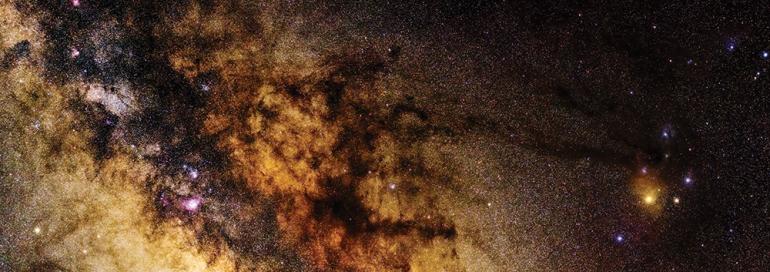Giants in the Summer Sky
What to look for this season.
The Big Sky has some big players in it this summer, with the largest planets in our solar system holding court during our brief and balmier nights.
After the sun goes down and it (finally) gets dark, look for the fishhook-shaped constellation of Scorpius the scorpion dragging its tail along the southern horizon. Right behind it (to its east) comes the teapot shape of Sagittarius the archer. And hot on Sagittarius’ tail (again to its east) come two bright unblinking lights: the planets Jupiter and Saturn.
Early in the summer, it will take a while for the planets to rise in the southeast. But on July 14 for Jupiter and July 20 for Saturn, the planets rise at sunset and are in the sky all night—at their brightest for the year. That’s because they lie on the same side of the sun as we do, and they’re closest to us in their respective orbits.
They also appear close to each other as we view them in the sky, though they’re not really. Jupiter lies about 385 million miles away, and Saturn behind it is more than twice as far at 836 million miles. That distance gap and Saturn’s smaller disk largely explain the considerable brightness difference; brilliant Jupiter appears about eleven times brighter.

As chummy as they may seem this summer, Jupiter and Saturn were never really close in Roman mythology—nor were their Greek counterparts, Zeus and Cronus. Cronus was the father of Zeus and the previous king of the gods. He had the nasty habit of snacking on his newborn children, because of a prophesy that he would be overthrown by one of them. Zeus, the last, was saved from consumption when his mother Rhea hid him at birth. He subsequently grew up, induced his father to disgorge his siblings, and then, in fact, overthrew him to become the new king of the gods.
As Jupiter and Saturn, their relationship wasn’t quite so fraught; Saturn more or less retired to the farm to preside over agriculture, later morphing into “Father Time,” while Jupiter took over as the hurler of thunderbolts and guarantor of public oaths.
The cycling moon joins their little reunion regularly this summer, passing just below them—at the much closer distance to us of just under a quarter-million miles—on June 8-9, July 5, and August 1. On July 4, as it nears the planets in the sky for its July 5 tryst, the top of the moon will skim through the lower, outermost edge of the Earth’s shadow in space. This penumbral lunar eclipse will be at its maximum at 10:30pm MDT, just after the moon clears the ridgetops and the fireworks are over; but the gray shading on the Man-in-the-Moon’s bald noggin will be so slight as to be unnoticeable. Nonetheless, it will be easy to imagine the Earth’s shadow, the moon, Jupiter, and Saturn all strung out in the same general direction in space on that night.
A modest telescope, if you have access to one, can be profitably used this summer to view the rings of Saturn and the four main moons of Jupiter. Or pore through the online libraries of amazing photos from previous spacecraft missions to these giant, gassy worlds—notably Cassini for Saturn, Galileo for Jupiter, and the current Juno Mission as well for Jupiter, since it still circles the planet as you read.
And be a player in the summer night sky yourself by going out to regard these fellow travelers against the panoply of the universe. The nights will never be warmer!












